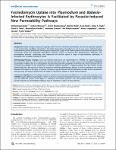Fosmidomycin Uptake into Plasmodium and Babesia-Infected Erythrocytes Is Facilitated by Parasite-Induced New Permeability Pathways
Baumeister, Stefan
Wiesner, Jochen
Reichenberg, Armin
Hintz, Martin
Bietz, Sven
Harb, Omar S.
Roos, David S.
Kordes, Maximilian
Friesen, Johannes
Matuschewski, Kai
Lingelbach, Klaus
Jomaa, Hassan
Seeber, Frank
Background: Highly charged compounds typically suffer from low membrane permeability and thus are generally regarded as sub-optimal drug candidates. Nonetheless, the highly charged drug fosmidomycin and its more active methyl-derivative FR900098 have proven parasiticidal activity against erythrocytic stages of the malaria parasite Plasmodium falciparum. Both compounds target the isoprenoid biosynthesis pathway present in bacteria and plastid-bearing organisms, like apicomplexan parasites. Surprisingly, the compounds are inactive against a range of apicomplexans replicating in nucleated cells, including Toxoplasma gondii. Methodology/Principal Findings: Since non-infected erythrocytes are impermeable for FR90098, we hypothesized that these drugs are taken up only by erythrocytes infected with Plasmodium. We provide evidence that radiolabeled FR900098 accumulates in theses cells as a consequence of parasite-induced new properties of the host cell, which coincide with an increased permeability of the erythrocyte membrane. Babesia divergens, a related parasite that also infects human erythrocytes and is also known to induce an increase in membrane permeability, displays a similar susceptibility and uptake behavior with regard to the drug. In contrast, Toxoplasma gondii-infected cells do apparently not take up the compounds, and the drugs are inactive against the liver stages of Plasmodium berghei, a mouse malaria parasite. Conclusions/Significance: Our findings provide an explanation for the observed differences in activity of fosmidomycin and FR900098 against different Apicomplexa. These results have important implications for future screens aimed at finding new and safe molecular entities active against P. falciparum and related parasites. Our data provide further evidence that parasite-induced new permeability pathways may be exploited as routes for drug delivery.
Dateien zu dieser Publikation
Keine Lizenzangabe

